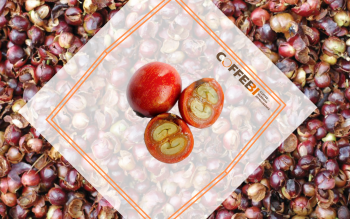The dried husk of the coffee cherry that’s hitting the markets
Cascara, the dried husk of the coffee fruit, also often referred to as the coffee cherry, has gained a lot of attention recently. Once considered just a byproduct of the coffee drying process with little commercial value and often discarded, early innovators now upcycle cascara into a variety of food products, particularly beverages.

In recent years, articles in coffee and beverage industry magazines, as well as more mainstream media outlets, have covered a wide range of cascara related topics. With the proliferation of cascara beverages hitting the markets internationally through small startups and major players such as Starbucks and research indicating that cascara was a superfood, prices of cascara have reportedly surged past that of its green coffee counterpart. Coupled with the apparent “ban” on the sales of cascara to EU consumers, this has provided plenty to report on.
For the last few hundred years, the popularity of the roasted green seed of the coffee fruit that the world has come to know and love as coffee has overshadowed cascara. Although cascara, which goes by different names depending on the region, was consumed for hundreds of years in coffee producing regions that are now located in countries such as Yemen, Ethiopia, Kenya, and Bolivia as well as areas that are now within other Middle Eastern and African countries, the consumption of cascara didn’t occur in the more industrialized nations until about 2006. Cascara didn’t start to gain traction until as recently as 2013 in parts of Europe, Australia, Japan, and the United States (Read also How to Select a Good Cascara?).
Cascara (from coffee) is not to be confused with Cascara sagrada, the dried bark of the buckthorn bush, which is a well-known laxative! Both share the name “Cascara”, which is Spanish for “husk” or “shell”. In Spanish, cascara (from coffee) is referred to as “Cáscara del Café”, which thus avoids any confusion. But in English, although there was some debate on what the final consumer term should be, the word “Cascara” has stuck. The use of the word “cascara” emerged from the world of specialty coffee. Starbuck’s legitimized its use in the mainstream with the launch of Starbuck’s Cascara Latte in the USA in early 2018. The accompanying promotional campaign greeted customers as they entered the cafes with a standing poster titled “What is Cascara?”.
Although different drying methods can be applied to the coffee cherry to produce cascara, like other dried fruits, there is no way of distinguishing the drying process of the fruit or the separation of the fruit from the seed in the name itself. Cascara is cascara whether it comes from the natural or dry, washed or pulped, or the honey process, or if it is sun-dried or machine dried. Although each method can result in a very different product with different characteristics and qualities, these methods will fall into the hands of smart marketers and brand owners seeking to differentiate their products.
This five-part series will attempt to provide a 360-degree view of cascara dispelling the fact from the fiction. The series will cover the following topics: the EU Novel Food Regulation and food safety risks; nutrition and health; varietal differences - nutrition, flavor, and quality; and new products and innovations as the drivers of what is appearing to be a new functional ingredient in the food and beverage space and a new beverage category altogether.



